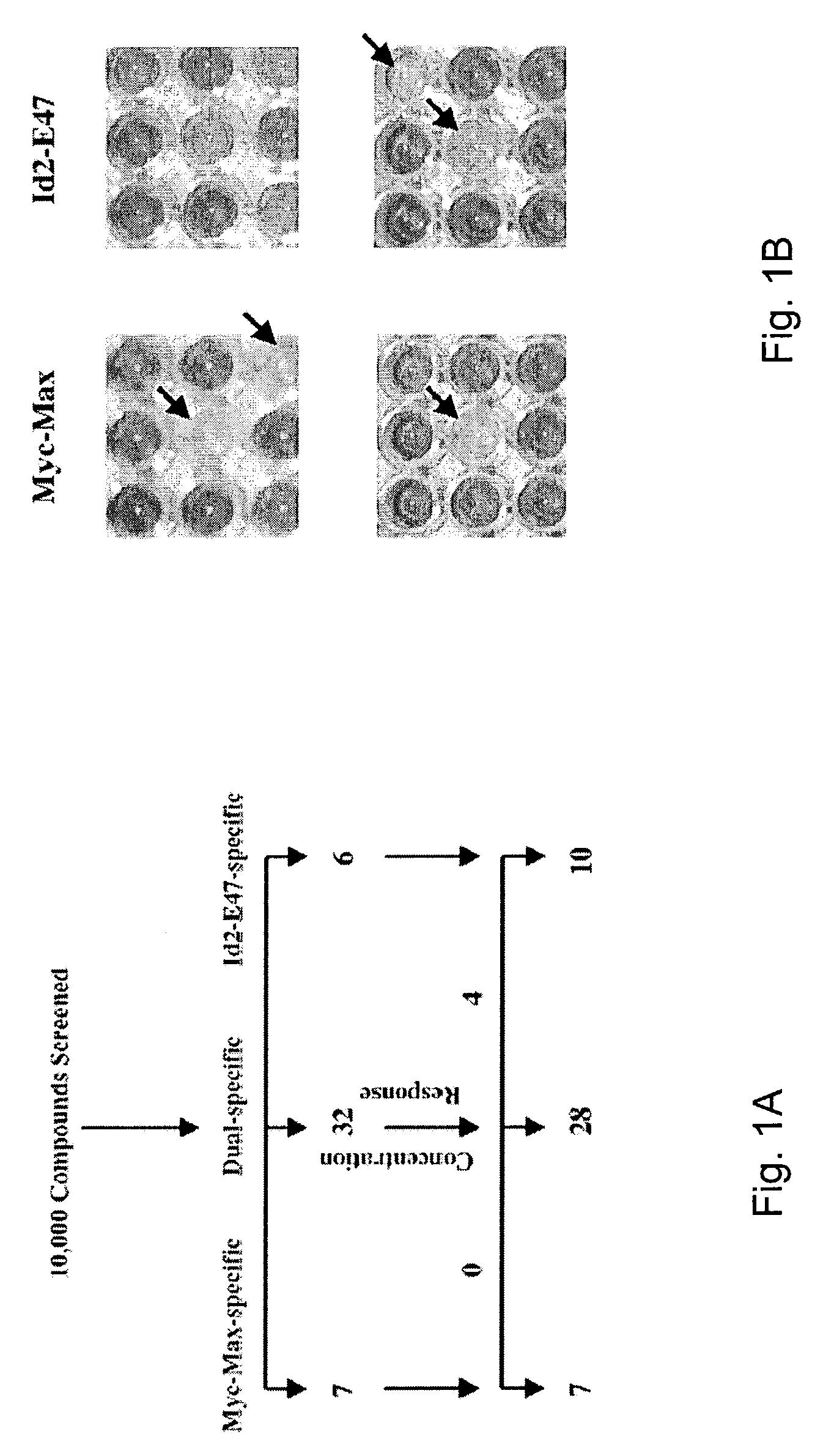Pharmacologic inhibition of Myc function
a myc target gene and drug technology, applied in the field of myc target gene specific inhibition therapy, can solve the problems of limited experimental success, theoretical and practical limitations, and the inability to achieve specific inhibition of individual myc target gene products
- Summary
- Abstract
- Description
- Claims
- Application Information
AI Technical Summary
Benefits of technology
Problems solved by technology
Method used
Image
Examples
example 1
Identification of c-Myc-Max-Specific Compounds by Yeast Two-Hybrid Screening
[0051]A yeast two-hybrid-based approach (Bai C and Elledge S J, (1996), Methods Enzymol., 273: 331–347) in which the HLH-ZIP domains of c-Myc and Max were fused to the DNA-binding domain (BD) and transcriptional activation domain (AD), respectively, of the yeast Gal4 transcription factor (Langlands K, et al. 1997; Yin X Y, et al., 1999a). The association between c-Myc and Max results in the de facto reconstitution of a fully functional transcriptional activator. A β-galactosidase gene containing a Gal4-binding site in its promoter and residing within the yeast genome, is induced upon the binding of c-Myc-Max, thus providing a simple, rapid, and quantitative readout of the proteins' dimerization status. Compounds that disrupt this association should therefore prevent induction of the enzyme. To control for nonspecific effects, a second yeast strain was created in which BD and AD fusions with the HLH proteins ...
example 2
Specificity of Myc-Max Compounds and Their Effects on Myc-Max Heterodimers
[0054]To assess further the inhibitory profiles of the above compounds, 32 additional yeast strains were created that express various interacting pairs of HLH-, ZIP-, or HLH-ZIP-containing proteins fused to the above Gal4 domains. Construction of these yeast strains is described in Langlands et al., 1997 and Yin et a., 1999a. This multiplex system was then used to test each of the Myc-Max- and Id2-E47-specific compounds, and 11 of the dual-specific compounds for their abilities to inhibit β-galactosidase activity in each strain. As seen in FIG. 2, both the Myc-Max and Id2-E47 compounds demonstrated remarkable specificities for their originally identified targets. Thus, of the 231 possible combinations of Myc-Max-specific compounds with yeast expressing other protein pairs, only seven (3%) produced marked β-galactosidase inhibition, and of these, three involved the interaction between Max and a Mad family prote...
example 3
Inhibition of Mammalian Cell Growth by Myc-Max Specific Compounds
[0058]Since c-Myc is necessary for the proliferation of mammalian cells (Prochownik, E. V., J. Kukowska, and C. Rodgers (1988), Mol. Cell. Biol., 8:3683–95; I. M. deAlboran, et al. 2001), it was next determined whether the Myc- Max-specific compounds could inhibit this process. Control Rat1a fibroblasts (Rat1a-neo cells) or Rat1a cells transfected with a c-Myc expression vector (Rat1a-c-Myc cells; Yin et al., 1999b) were grown in the presence of each compound and viable cell counts were performed periodically thereafter. As seen in FIGS. 4A and 4B, all of the compounds strongly inhibited the growth of each cell line. During the initial 5–6 days, this was not accompanied by apoptotic cell death, with >90% of the cells remaining viable as determined by trypan blue staining and TUNEL assays (not shown). Longer periods of incubation, however, were accompanied by significant apoptosis in each case. These results are consist...
PUM
| Property | Measurement | Unit |
|---|---|---|
| Molar density | aaaaa | aaaaa |
| Molar density | aaaaa | aaaaa |
| Molar density | aaaaa | aaaaa |
Abstract
Description
Claims
Application Information
 Login to View More
Login to View More - R&D
- Intellectual Property
- Life Sciences
- Materials
- Tech Scout
- Unparalleled Data Quality
- Higher Quality Content
- 60% Fewer Hallucinations
Browse by: Latest US Patents, China's latest patents, Technical Efficacy Thesaurus, Application Domain, Technology Topic, Popular Technical Reports.
© 2025 PatSnap. All rights reserved.Legal|Privacy policy|Modern Slavery Act Transparency Statement|Sitemap|About US| Contact US: help@patsnap.com



